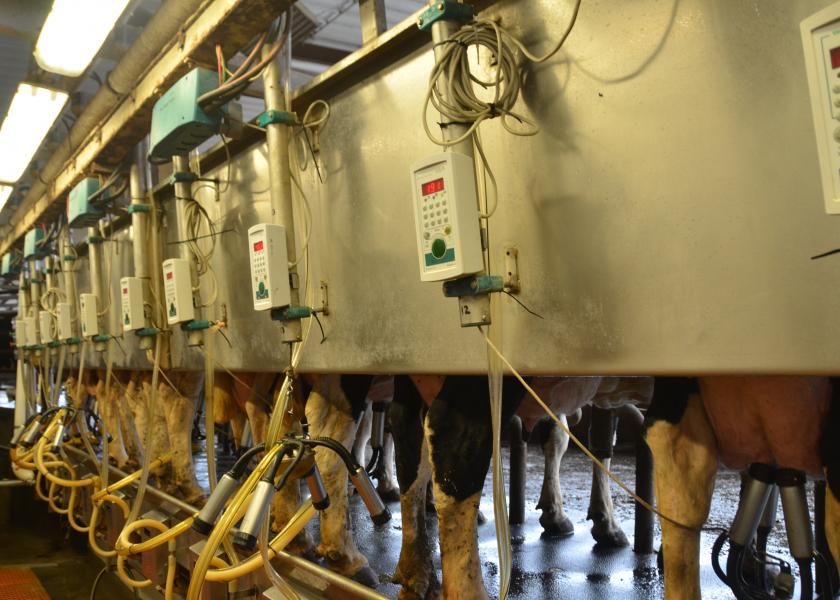Are You Overmilking?

In Part 1 of this series (Manage Milking Efficiency), we discussed milking efficiency, defined as the percent of unit on-time (cluster attached) that milk is flowing near maximum. For example, if a milking unit is attached for five minutes to a cow during milking, and strong milk flow occurs for four minutes and 45 seconds, her milking efficiency is 95% (285/300 seconds). When milk isn’t flowing while the unit is attached, it is not only ineffi-cient but, more importantly, can damage teat tissue and thus could increase the risk of mastitis and decrease milk yield.
As stated in Part 1, most dairy farms evaluate and maintain milking equipment on a routine basis. Although proper equipment function is necessary for milking efficiency, it does not necessarily guarantee it. Two management areas that lead to poor milking efficiency are milking routines that don’t achieve consistent milk letdown and overmilking. Either one of these problems can leave cows “high and dry” for a period of time, and expose teats to high vacuum levels. In this article, we’ll discuss overmilking, which is a problem that occurs at the end of milking.
MORE THAN 30 SECONDS
After a milking is completed, the vacuum should be turned off and cluster removed from the cow as soon as possible. Generally, it is undesirable to have units attached for more than 15 seconds after milking completion, and units that are attached for more than 30 seconds after milking are considered to be overmilking.
How do you recognize overmilking? A simple way is to hand strip the udder after the unit is detached. A cup of milk should be easily attained without overworking the teats. As mentioned in Part 1, milk flow can also be estimated with digital vacuum recorders (VaDia, Biocontrol NA). A simple rule for interpreting VaDia results relative to milk flow is:

VaDia units can measure vacuum levels at four different places on the cluster simultaneously. We often measure vacuum in the mouthpiece of a front and rear liner, near the cluster and in a short pulsation tube.
In Figure 1, Cow 1 was ready to milk; the vacuum in the liner mouthpiece near the teat (red and blue lines) dropped quickly (less than 10 seconds after the unit was attached) and remained low until each teat was finished milking (the front quarter [blue line], finished before the rear quarter [red line]). At the end of milking, although the front quarter was done milking for nearly two minutes before unit take-off, the rear quarter continued to milk until about 15 seconds before unit take-off and thus was not overmilked. Cluster vacuum (green line) continued to fluctuate in a range of about 2" of mercury (inHg) during this milking time, suggesting milk flow for the cow was continuous.

What about Cow 2, Figure 2? Milk flow started soon after cluster attachment, but vacuum in the front and rear quarters increased to near maximum and plateaued two minutes before unit take-off. Also, the cluster vacuum (green line) increased to maximum vacuum during this time with little variation, which suggests little or no milk flow. This cow was overmilked.

BAD FOR TEAT HEALTH
So how does overmilking milking affect milking efficiency? For Cow 1, milk was flowing for about four minutes and 30 seconds of the total unit on time of four minutes and 45 seconds, or a milking efficiency of about 95%. For Cow 2, milk was flowing for about four minutes and 30 seconds of the total milking time of seven minutes and 30 seconds, or a milking efficiency of about 60%. Why does this matter?
Unnecessary high vacuum is never good for teat health. Additionally, it’s common for overmilked cows to have extended unit on-times. This reduces cow throughput in the parlor and extends the length of time that is needed to milk a herd. Also, slower parlor efficiency requires cows to stand in the holding pen and parlor for longer periods of time, reducing the time they spend resting and eating. Anecdotally, by reducing overmilking and decreasing unit on-time by just a couple minutes per cow, some herds have reported decreasing the duration of a milking shift by at least 45 minutes, or decreasing the total milking time by about two hours per day for a three-time-per-day milking herd.
The most common causes of overmilking are lack of automatic detachers, automatic detachers that are not operating properly, or the tendency to have milking operators place the detach mode to manual. This often occurs when operators are frustrated with detachers that aren’t functioning well or the mistaken belief that cows need to be milked out dry. Cow 3 Figure 3, is a VaDia plot of overmilking that occurred from reattaching the cluster after the cow was done milking, note the drop in all vacuum lines while the unit was off the cow.

Herds with shorter duration of milking shifts are more likely to have increased overmilking as opposed to herds that use their facilities for the maximum hours each day.
For more on this, read:







